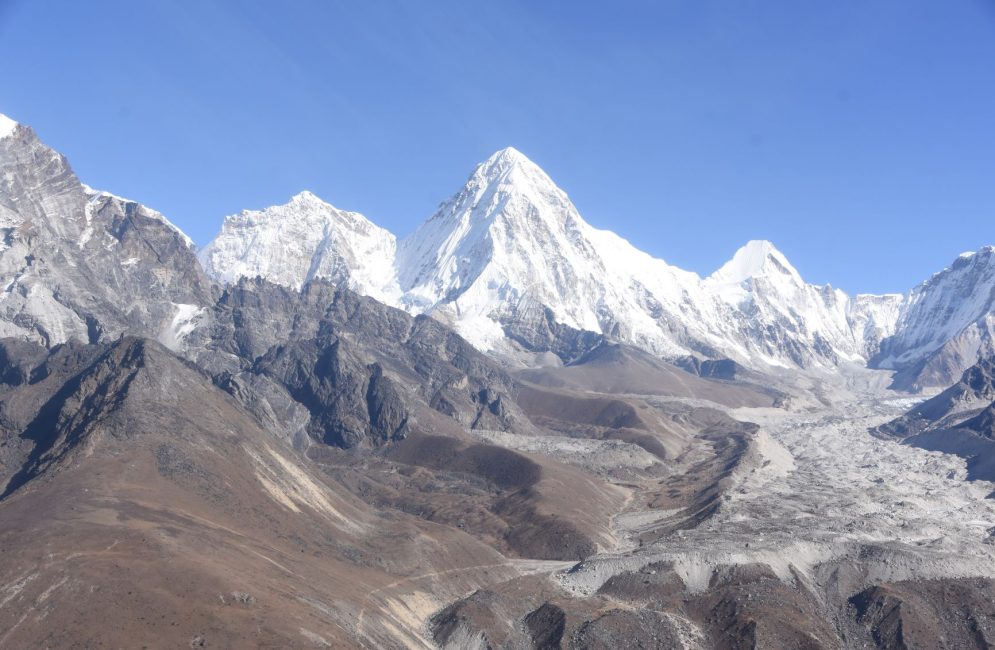
The Everest Base Camp is one of the most iconic destinations you can ever imagine globally.
Its Southern side lies in Nepal at a height of 5,364 m, while North Base Camp is in Tibet, China, at an altitude of 5,150 m.
To acclimatize and lower their risk of altitude sickness, climbers often take a few days off in base camp. Everest cannot be seen from the base camp itself. Other mountains impede the view.
But from the Everest Base Camp, you can take in views of the Khumbu Icefall and the Khumbu Tse (6,636 m), which gives you a genuinely humbling sense of nature’s majesty.
Trek to Everest Base Camp
Everest Base Camp Trek is one of the world’s most well-known and recognizable treks.
Trekking to Everest base camp involves following in the footsteps of Tenzing Norgay Sherpa and illustrious Sir Edmund Hilary.
Along with the breathtaking view of Mount Everest, picturesque landscape, and rustic villages, the journey will provide you with a whole trip to enjoy, starting from day one.
This trip is made interesting by ancient festivals, Sherpa culture, and regional cuisine.
The journey resembles a pilgrimage because of Buddhist chants, prayer wheels, and flags along the way. The monasteries and influence of Buddhism add to the spirituality of the journey.
The short flight from Kathmandu to Lukla marks the start of the Everest Base Camp trek. You will journey to native Sherpa settlements, vivid with their distinctive culture and way of life, close to the Himalayas.
You will then hike back to Lukla from Mount Everest base camp. Phakding, Namche Bazaar, Tengboche, Dingboche, and Lobuche are all passed along the trail.
Namche Bazaar, Sagarmatha National Park, Tengboche Monastery, Gorakshep, Kalapatthar, and Mount Everest Base Camp are the highlights of the Everest Base Camp Trek.
The trip highlights include:
- An exciting sightseeing flight to Lukla
- A chance to interact with the friendly Sherpa people
- World Heritage Site, Sagarmatha National Park.
- The Kalapatthar viewpoint, where hikers may obtain a panoramic view of Mt. Everest (8,848.86 m), Changtse (7,543 m), Lhotse (8,516 m), and Nuptse (7,861 m).
- Tall suspension bridges, whirling prayer wheels, and vibrant mani stone walls.
- The up-close view of the Khumbu icefall and a snow-fed glacier from Everest Base Camp.
- Visit the world’s highest Mountain Base Camp.
The temperature at Everest Base Camp
The EBC journey is most enjoyable in the spring (March to May) and autumn (September to November). The sky is clear, and the temperature is just right to enjoy the unobstructed view of the mountains.
The hike is not recommended during the winter (December–February) and monsoon season (June–August). While there is a lot of snow and fog in the winter, there is a lot of rain during the monsoon season. During these times of the year, flights to and from Lukla are frequently canceled and delayed.
The average temperature at the base camp on Everest is generally below freezing. The temperature ranges from 7 °C to 15 °C during the day and -12 °C to 0 °C at night in the spring. In monsoon, the temperature ranges from 16 °C to 15 °C during the day and -1 °C to 2 °C at night.
In the autumn, the temperature ranges from 6 °C to 15 °C during the day and -12 °C to 2 °C at night. Besides, in winter, the temperature ranges from 4 °C during the day and -17 °C to -14 °C at night.
How to prepare for the EBC Trek
To prepare for the EBC trek, you will have to pack proper clothing and trekking gear as well as apply some safety measures.
You will require at least a heavy fleece or down jacket, waterproof jacket with hood, and some wind and waterproof jacket and pants.
Likewise, running shoes and evening sandals with hiking socks are required. One lightweight wool jumper/sweater/fleece during summer and one heavyweight or two lightweights during winter is also needed, along with long sleeve shirts, warm hats, wool or fleeced, and Gore-Tex gloves.
For the trek, you will also need a good sleeping bag (-20 °C rated).
Likewise, you will need a waterproof day pack (25-30 L) for carrying personal belongings, trekking poles, and torch/flashlight headlamp style.
Similarly, you should carry sunscreen, a first-aid kit containing aspirin, bandages, anti-histamine, Imodium, or similar tablets for mild cases of diarrhea; Diamox (in case of altitude sickness); and other personal medical prescriptions.
Since it is a high-altitude trek, you should also control the intake of alcohol and coffee. You should be adequately hydrated to avoid headaches, which can also help prevent altitude sickness.
Besides, you should allow plenty of time to acclimatize and make the journey safe.
The journey to Everest Base Camp is a little challenging. About two weeks will be required to undertake this trek.
The EBC Trek does not require prior trekking experience, although it is advised that the trekker be committed and in good physical condition.
You should be physically capable of carrying a light backpack for four to five hours a day and be mentally prepared for this challenge.
Hence, before embarking on this walk, you must prepare your body by engaging in physical exercises.
Conclusion
The chance to hike to Everest base camp comes only once in a lifetime. You will travel to some of the most breathtaking locations on Earth when you reach Everest Base Camp.
The hike is worth it because of the breathtaking 8,000-meter views in front of you, the ruggedly gorgeous Himalayan environment, and the general spiritual atmosphere created by encounters with Mani walls, stupas, and Buddhist prayer flags.
You also experience local Sherpa culture and customs firsthand and learn about their way of life. Additionally, one of the world’s oldest and most revered monasteries, Tengboche, will be visited.






